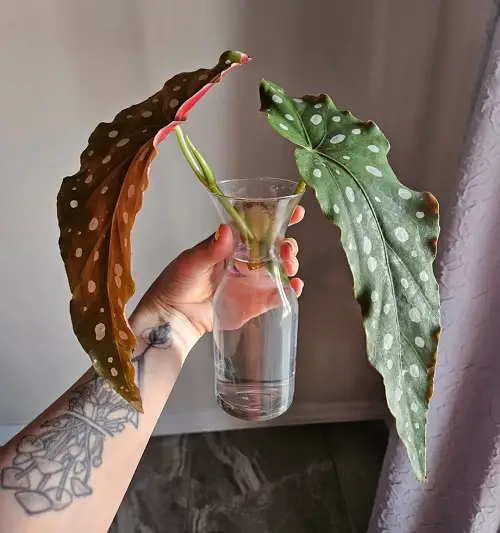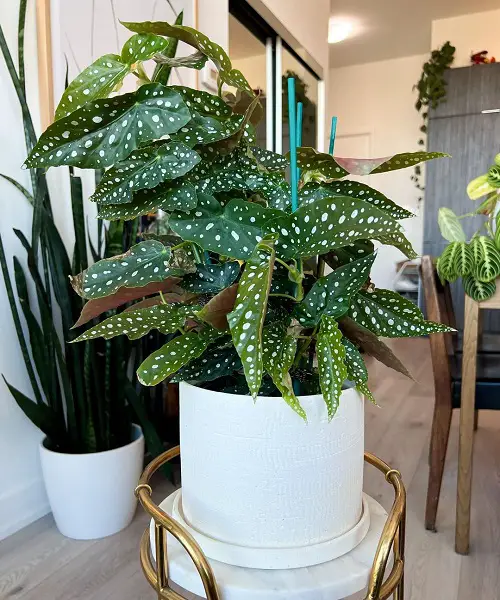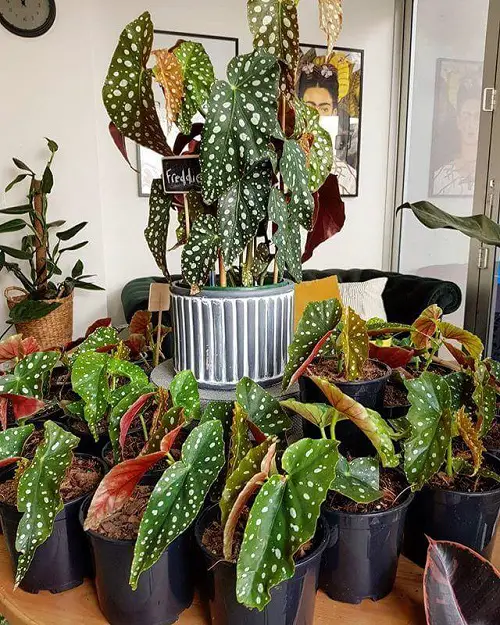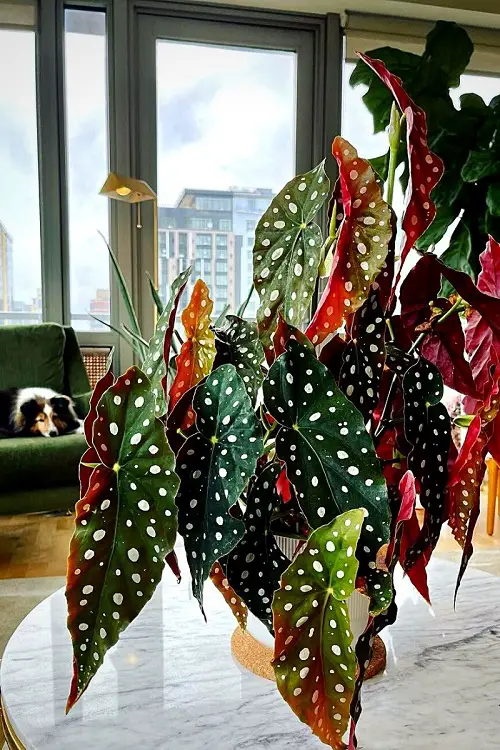Discover the secrets to growing and caring for the resilient and striking Begonia Maculata! It’s a great all-round indoor plant!
With its striking polka dot leaves and delicate flowers, this plant is a favorite of many indoor gardeners. But what makes it really stand out is its resilience and low-maintenance needs. Whether you’re a seasoned plant parent or just starting out, this Begonia Maculata Care and Growing Guide will help you out!
Have a look at the best types of Rex Begonias here
Begonia Maculata Plant Information
Begonia Maculata, also known as Polka Dot Begonia, is a tropical plant species that is native to Brazil, particularly in the Mata Atlantica forest. This stunning plant belongs to the Begoniaceae family, which includes over 1,800 different species of begonias.
Begonia Maculata is well-known for its distinctive and eye-catching appearance, featuring large, asymmetrical leaves with a unique pattern of white dots on a vibrant green background. The plant can grow up to 2-3 feet tall and spread about 1-2 feet wide, making it a great choice for a medium-sized houseplant.
One of the unique characteristics of Begonia Maculata is its ability to produce delicate pinkish-red flowers that bloom during the summer months. It also has air-purifying qualities, making it a great choice for improving indoor air quality.
Here are Outstanding Begonia Types & Varieties To Grow In Shade & Indoors
Propagating Begonia Maculata

Begonia Maculata can be easily propagated from stem cuttings or by division.
From Stem Cuttings:
- For stem cuttings, select a healthyBegonia Maculata stem that has at least one node and several leaves. Cut the stem just below a node, removing any lower leaves.
- Dip the cut end of the stem into rooting hormone and plant it into a well-draining potting mix. Keep the soil moist and the cutting in a bright, warm spot out of direct sunlight.
- Cover the cutting with a plastic bag to create a mini greenhouse and promote humidity.
- After a few weeks, you should see roots beginning to form.
- Once the cutting has established roots and new growth, it can be transplanted into its own pot.
Learn How to Propagate Rex Begonias From Leaf Cuttings here
From Division:
- Gently remove the Begonia Maculata from its pot and gently separate the root system into smaller sections. Each section should have at least one stem and several leaves.
- Plant each section into its own pot with fresh, well-draining potting mix. Water the newly potted sections and place them in a bright spot with indirect sunlight.
- Keep the soil moist but not waterlogged, and mist the leaves regularly to promote humidity.
- With proper care, propagated Begonia Maculata plants can grow and thrive just as well as the original plant.
Note: Both stem cuttings and division should be done during the plant’s active growing season, typically in the spring or summer months.
Here are the Best Pink Begonia Varieties
Requirements for Growing Begonia Maculata

Sunlight
Begonia Maculata thrives in bright, indirect sunlight. It can also tolerate some direct sunlight during the morning or evening hours.
However, it is important to avoid direct sunlight during the hottest part of the day, as this can cause the leaves to burn.
Soil
The plant prefers well-draining soil that is rich in organic matter. A good potting mix forBegonia Maculata should contain a mixture of peat moss, perlite, and sand.
It is also important to ensure that the soil is slightly acidic, with a pH between 5.5 and 6.5.
Learn How to Check Your Soil pH at Home here
Water
Begonia Maculata requires consistently moist soil, but it is important to avoid overwatering. Water the plant when the top inch of soil feels dry to the touch, and make sure to allow any excess water to drain away.
During winter months, when the plant is not actively growing, reduce watering to prevent waterlogged soil.
Here are Signs of Overwatering & How to Save an Overwatered Plant
Temperature and Humidity
It prefers warm temperatures, with a range between 60-85°F (15-28°C). It is important to avoid exposing Begonia Maculata to temperatures below 55°F (12°C), as this can cause damage.
Additionally, Begonia Maculata thrives in high humidity levels, so it is important to provide a humid environment.
Misting the leaves regularly can help to increase humidity levels. You can also place a tray of water near the plant to increase humidity or use a humidifier.
Here are 10 Ways To Increase Humidity For Houseplants That Work
Begonia Maculata Care

Fertilizer
Begonia Maculata benefits from regular fertilization during the growing season, typically from spring through summer. A balanced, water-soluble fertilizer, diluted to 1/2 of its strength, once in 4-6 weeks will be more than enough to boost the growth.
During winter months, when the plant is not actively growing, eliminate fertilization.
Want to Make Organic Fertilizers from Kitchen Scraps? Click here
Pruning
Pruning is an important part of maintaining the health and appearance of your Begonia Maculata. Prune the plant regularly to remove any dead, damaged, or diseased foliage.
You can also prune back leggy growth to promote a fuller, bushier shape. Pruning can be done at any time of year, but it is best to avoid heavy pruning during the winter months when the plant is not actively growing.
Pests and Diseases
Begonia Maculata is generally a low-maintenance plant, but it can be susceptible to a few common pests and diseases. Spider mites, mealy bugs, and scale insects can all infest the plant, causing damage to the foliage.
To prevent these pests, regularly inspect the plant and remove any affected leaves or stems. If an infestation is severe, you can use an insecticidal soap or neem oil.
Begonia Maculata is also susceptible to root rot .ed, which is caused by overwatering and poorly draining soil. To prevent root rot, allow the soil to dry out slightly between waterings and ensure that the pot has adequate drainage.




